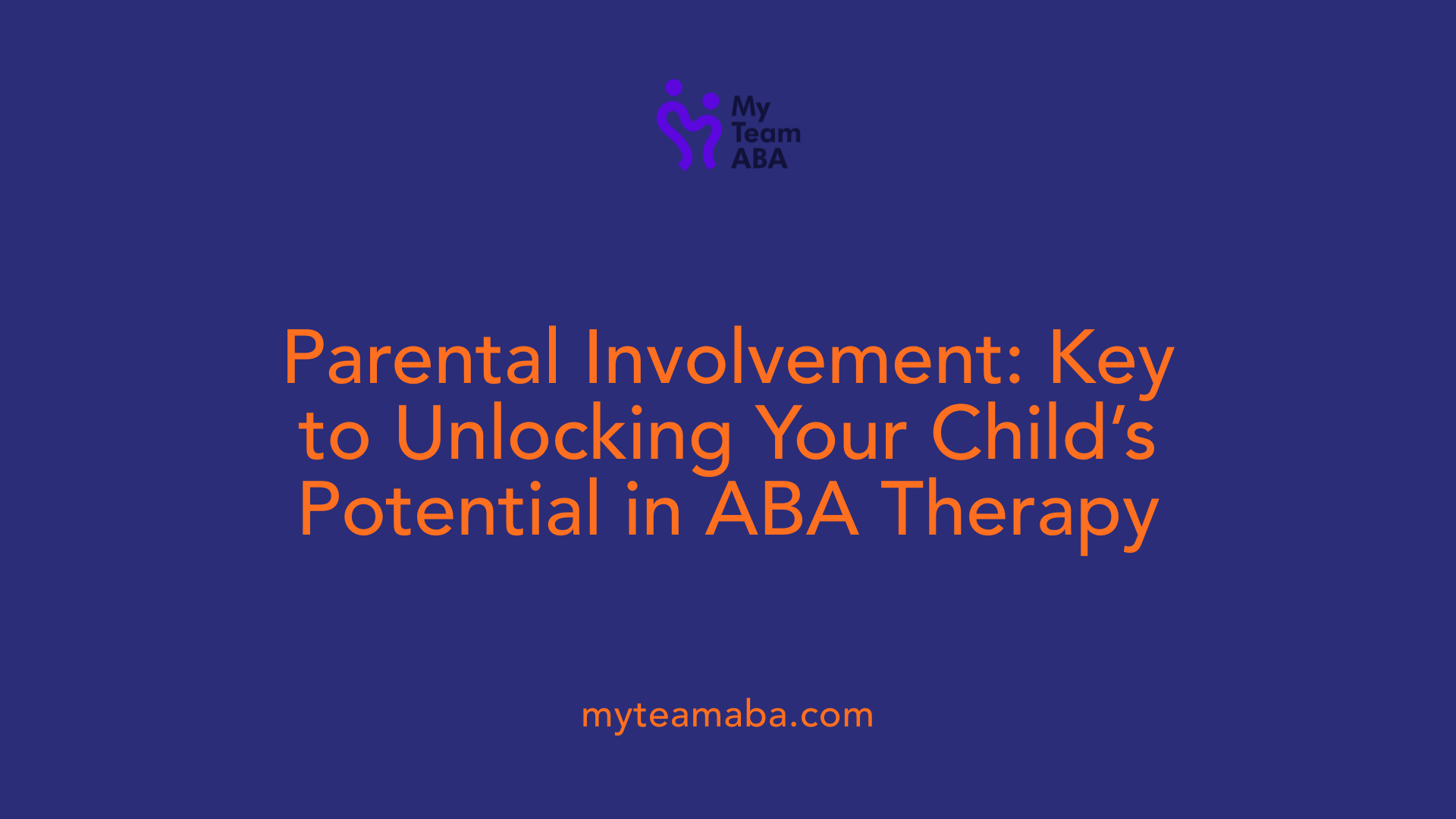How to Stay Involved in Your Child’s ABA Therapy Journey
July 24, 2025
Empowering Parents for Effective ABA Engagement

Introduction: The Critical Role of Parental Involvement in ABA Therapy
Parent involvement is a cornerstone of successful ABA therapy for children with autism. It extends beyond the therapy sessions, encompassing active observation, consistent reinforcement, and ongoing collaboration with therapists. This article explores effective strategies for parents to stay involved, the benefits of their participation, common challenges faced, and resources available to empower them through this journey.
Understanding the Importance of Parental Engagement in ABA Therapy

What is the role of parents in reinforcing skills outside therapy sessions?
Parents play a central role in reinforcing the skills their children learn during ABA therapy outside of structured sessions. By observing therapy practices, parents gain insight into the strategies used and how to replicate them at home. This ongoing reinforcement helps children generalize learned skills across various environments, such as home, school, and social settings.
Practicing routines, using visual supports like schedules or charts, and applying positive reinforcement consistently are all ways parents can support skill mastery. For example, encouraging a child to greet others politely or manage self-care tasks through daily routines helps embed these behaviors into everyday life.
Moreover, reinforcing behaviors shortly after they occur, combined with praise or rewards, strengthens the likelihood that children will repeat these behaviors. Regularly applying ABA principles at home ensures consistency, which is crucial for long-term success.
What benefits does parental involvement bring to a child's progress?
The involvement of parents in ABA therapy significantly accelerates a child's developmental progress. When parents actively participate, they help reinforce new behaviors learned during therapy, leading to quicker mastery and better retention.
Additionally, parental engagement fosters consistency across multiple settings. Children tend to thrive when strategies used in therapy are simultaneously applied at home, creating a seamless learning environment.
Parents also serve as behavioral models, demonstrating appropriate responses and emotional regulation, which children imitate. This modeling enhances social and emotional development.
Research shows that children whose parents are involved tend to show greater gains in communication, social skills, and behavioral improvements. Parental involvement also boosts the child's confidence and motivation, seeing their family as a team committed to their growth.
How can active participation strengthen emotional bonds?
Active participation in ABA therapy can deepen the emotional connection between parents and children. Engaging in therapy sessions, observing progress, and practicing skills foster a sense of shared purpose.
Parents who participate actively often report feeling more connected to their child's journey, which enhances trust and security. When children see their parents involved and supportive, they feel more valued and understood, reducing anxiety or resistance to therapy.
Participating in training sessions and routine practice not only helps parents understand their child's needs but also encourages positive interactions based on encouragement and praise. Such interactions can nurture feelings of safety, love, and mutual respect.
Furthermore, celebrating small victories together boosts emotional bonds, reinforcing the child's motivation and strengthening the parent-child relationship.
Why is finding a balance between involvement and independent learning important?
While parental engagement is vital, it is equally important to allow children to learn independently within a safe environment. Finding this balance helps children build resilience and confidence in their abilities.
Over-involvement can sometimes lead to dependence or frustration, whereas overly distant parenting might fail to provide the necessary reinforcement. Effective ABA programs emphasize collaborative involvement, where parents support skills development without overshadowing the child's opportunity to explore and problem-solve.
Therapists often advise parents to encourage autonomy in tasks and gradually increase independence as the child progresses. This approach ensures that children develop self-regulation skills and can adapt learned behaviors across diverse situations.
How does family involvement facilitate integration of ABA strategies into daily routines?
Integrating ABA strategies into daily routines is crucial for consistent learning. Parent training and ongoing routine practice help make therapy strategies a natural part of family life.
Participating in parent training sessions allow parents to understand specific techniques tailored to their child's needs. Afterward, applying these strategies during regular activities—such as mealtime, playtime, or self-care—reinforces learning.
Using visual cues like schedules or charts during daily routines helps children anticipate and understand what is expected, reducing anxiety.
Collaboration with therapists ensures that routines are aligned with therapeutic goals and adjusted as necessary for the child's growth. When families actively incorporate ABA strategies into everyday life, the skills become more meaningful and sustainable.
How does the environment at Inner Circle support parental engagement?
Inner Circle recognizes the importance of family involvement and provides resources like observation rooms, where parents can see their child's therapy in action. These observation sessions allow parents to witness strategies firsthand and ask questions.
Regular meetings with therapists, such as Sarah Varillas BCBA and Crystal Lissuzzo M.Ed., BCBA, LBA, emphasize transparency and open communication. This ongoing dialogue helps parents stay informed and actively participate in goal setting.
Moreover, Inner Circle offers parent training, workshops, and access to educational resources to improve understanding and application of ABA techniques at home. This comprehensive approach ensures that parents are equipped to support their child's progress outside of sessions.
How can parents optimize collaboration with ABA professionals?
Effective parent-therapist collaboration is rooted in open communication, mutual respect, and shared goals. Regularly scheduled meetings provide opportunities to discuss progress, concerns, and strategies.
Parents should feel encouraged to ask questions, share observations from home, and provide feedback on what is working or not. This information helps therapists tailor interventions to better suit the child's needs.
Participation in training and workshops offered by professionals like those at Inner Circle increases confidence and understanding of ABA principles. It also enables parents to implement techniques more effectively.
Maintaining consistent communication via calls, emails, or meetings ensures that everyone involved remains aligned, fostering a team-oriented approach that benefits the child's development.
What practical tips can help parents support ABA therapy at home?
Parents can support ABA therapy through several practical strategies:
- Observe therapy sessions to learn techniques and understand their child's progress.
- Practice learned strategies consistently during everyday activities.
- Create structured routines using visual schedules or charts.
- Reinforce behaviors immediately with praise or rewards.
- Maintain a distraction-free environment by minimizing noise and clutter.
- Collaborate with therapists to adapt strategies for home use.
- Track progress through journals or progress charts.
- Celebrate small successes to motivate the child.
- Prioritize self-care to manage stress and prevent burnout.
Incorporating these practices reinforces skills and encourages positive behavior, making therapy more effective overall.
What challenges might parents face and how can they overcome them?
Challenges such as balancing involvement with the child's need for independence, managing emotional stress, or handling setbacks are common.
To overcome these, parents should seek ongoing support from therapists, join parent support groups, and practice patience. Maintaining open communication with professionals helps in addressing concerns promptly.
Recognizing that progress takes time encourages perseverance. Celebrating small wins and setting realistic goals can foster a positive attitude.
Finally, self-care is essential—taking breaks, seeking social support, and engaging in relaxing activities helps maintain emotional well-being.
How does sustained parent involvement influence long-term outcomes?
Long-term, consistent parental involvement helps children retain skills, adapt them across environments, and develop independence. It also fosters a continued emotional connection, which can boost motivation and emotional resilience.
Even after formal therapy concludes, ongoing reinforcement and collaboration with professionals help maintain gains and support ongoing development.
Parents who remain actively engaged become advocates for their child's needs, ensuring access to resources and continued progress.
Overall, strong family involvement creates a supportive environment conducive to lasting positive change, empowering children to reach their full potential.
Creating a Supportive Environment at Home to Reinforce Therapy

What strategies can parents use at home and in other settings to support therapy participation?
Supporting therapy participation effectively at home involves establishing routines and structures that mirror those used during ABA sessions. Consistency in daily activities helps children feel secure and understand expectations. Using visual aids such as schedules, charts, or picture prompt boards sets clear cues for behaviors and tasks, making transitions smoother.
Creating a designated, distraction-free space is also crucial. A quiet, organized area minimizes sensory overload and helps the child focus on learning or practicing new skills. Reinforcing learned behaviors with positive rewards, like verbal praise, preferred activities, or tangible incentives, motivates the child and fosters engagement.
Partnering with ABA professionals ensures that strategies are tailored to the child's individual needs. Therapists can provide specific techniques and identify triggers or barriers, helping parents implement solutions across various environments. Practicing skills beyond therapy, in real-life settings like grocery stores or social gatherings, promotes generalization. It helps children transfer skills learned during sessions into everyday life.
Active parental involvement in goal setting, training, and routine practice creates a consistent experience for the child, which accelerates progress. This collaboration ensures strategies are applied accurately and meaningfully, fostering sustainable growth.
How can parents support their child's development through participation in ABA therapy?
Parents play a vital role in their child's developmental journey by actively engaging with ABA therapy. Attending parent training sessions allows them to observe therapy techniques, ask questions, and understand the rationale behind strategies. Practicing these techniques consistently at home helps reinforce behaviors and skills learned during sessions.
Working closely with therapists to set personalized, realistic goals ensures that interventions align with the child's needs. Regular communication, including feedback on progress and challenges, allows for adjustments and tailored support.
Utilizing educational resources like parent guides, videos, or online modules can deepen understanding of ABA principles. Creating structured routines and sensory-friendly environments supports skill acquisition and helps children manage sensitivities.
Maintaining ongoing dialogue with the therapy team ensures that strategies remain relevant and effective. Celebrating small successes motivates the child and builds confidence.
Overall, parental involvement boosts the child's motivation, develops a stronger parent-child bond, and enhances the long-term effectiveness of ABA therapy. Collaborating closely with professionals ensures strategies are consistently applied and adapted as the child develops.
Establishing routine and structure
A predictable environment is foundational for reinforcing ABA techniques at home. Routines provide a sense of security and help children anticipate what comes next, reducing anxiety and promoting cooperation.
Parents can create visual schedules to outline daily activities, such as morning routines, meals, playtime, and bedtime. These should be simple, consistent, and accessible for the child to reference.
Using visual aids and schedules
Visual supports like picture charts or step-by-step visual instructions serve as non-verbal cues that reinforce understanding. They are especially helpful for children with limited verbal communication or those who benefit from visual learning.
Incorporating visual aids in various settings encourages consistency and aids in generalization of skills.
Creating a distraction-free, positive home environment
A dedicated space free from clutter and sensory distractions enhances focus and learning. Use calming colors, comfortable seating, and minimal noise to maintain attention.
In this environment, parents can introduce engaging materials related to therapy goals, such as puzzles, books, or sensory toys, which promote skill practice.
Implementing these strategies requires ongoing effort and communication but results in a supportive space that fosters independence and progress.
| Strategy | Description | Practical Tip |
|---|---|---|
| Establishing routines | Creates predictability and reduces anxiety | Use visual schedules for daily activities |
| Visual aids | Support comprehension and task completion | Use picture charts to illustrate steps |
| Distraction-free environment | Minimizes sensory overload | Designate a quiet space for learning |
| Positive reinforcement | Motivates and encourages desired behaviors | Praise immediately after behaviors |
| Routine practice | Promotes skill transfer across settings | Practice greetings at home and in community settings |
Supporting ABA techniques at home and in various environments involves careful planning, collaboration, and consistency. Parents who implement these strategies create a cohesive support system that enhances their child's learning and overall development.
Effective Communication and Collaboration with Therapists

How can parents collaborate effectively with therapists to improve therapy outcomes?
Parents play a crucial role in supporting their child's progress in ABA therapy. Effective collaboration begins with maintaining open, honest, and respectful communication with the therapy team. Parents are encouraged to actively participate in treatment planning discussions, ask questions about therapy goals and strategies, and seek clarification when needed. This involvement ensures they fully understand the techniques used and how to implement them consistently at home.
Training and support from therapists empower parents to replicate therapy techniques, reinforcing skills learned during sessions. Building a strong relationship based on cultural humility, responsiveness, and reciprocity fosters mutual understanding and trust, which are essential for successful teamwork. Regular updates and feedback from therapists, including multidisciplinary providers such as speech-language pathologists, occupational therapists, and physicians, enable a coordinated approach tailored to each child's needs.
Furthermore, demonstrating empathy and compassion helps strengthen the partnership between parents and therapists. Recognizing that both parties share responsibility for the child's progress promotes a collaborative environment where everyone works towards common goals. Such teamwork not only improves therapy effectiveness but also creates a supportive network for the child.
What resources and guidance are available to help parents effectively engage in their child's ABA therapy?
Parents seeking to be active participants in their child's ABA journey can access a variety of resources and guidance. Participating in specialized training workshops and online courses offers practical knowledge of ABA techniques, giving parents confidence in applying these strategies at home. Educational materials, such as assessment tools like ABLLS-R and VB-MAPP, help track skill development and identify areas needing reinforcement.
Digital apps, such as Behavior Tracker Pro, are useful for monitoring behavioral changes, recording progress, and communicating updates with therapists. Joining parent support groups and online communities creates a network of shared experiences, advice, and emotional support, which can alleviate stress and enhance understanding.
Parents are also encouraged to observe therapy sessions whenever possible. This firsthand experience provides insight into effective techniques and helps reinforce learning at home. Open communication channels with behavior analysts and other team members ensure that parents stay informed about therapy plans and can provide valuable feedback.
Ultimately, consistent involvement, ongoing education, and utilizing available resources empower parents to be effective advocates for their child's development. This collaborative effort between families and professionals creates a cohesive environment where skills are generalized across settings and therapy goals are more easily achieved.
Monitoring Progress and Celebrating Achievements

How long should a child typically stay in ABA therapy?
The duration of ABA therapy for a child varies widely based on individual needs, progress, and goals. Typically, children remain in therapy for three to five years. Young children, especially those under age 3, often benefit from intensive schedules of 25 to 30 hours weekly. Some children might receive up to 40 hours of therapy weekly depending on their severity and specific needs.
Throughout therapy, frequent assessments help determine if the child is making adequate progress. Therapy length is often adjusted based on these assessments, with some children gradually reducing hours as they gain independence and mastery of skills. Many children require sustained, long-term intervention to achieve meaningful improvements in communication, social skills, and behavior. Overall, therapy duration is personalized, but consistent and intensive intervention tends to yield the best results.
Supporting Long-term Progress and Parental Self-care

How long should a child typically stay in ABA therapy?
The duration of Applied Behavior Analysis (ABA) therapy varies widely depending on each child's unique needs, developmental stage, and progress. Generally, for children with autism, therapy can last from three to five years, with some requiring longer periods. Younger children, especially those under age 3, often undergo intensive therapy, typically 25 to 30 hours weekly, and in some cases up to 40 hours for more substantial gains.
The length of therapy is regularly reviewed through ongoing assessments. Factors like the severity of symptoms and specific goals influence adjustments in duration and intensity. Most children experience gradual progress, and therapy may be tapered or concluded once they demonstrate sufficient independence and skill mastery. The overarching principle is that therapy should be as individualized as possible, with a focus on fostering sustainable, meaningful improvements.
In summary, while there is no fixed timeline, sustained engagement and tailored goals ensure children get the support they need for the best outcomes.
Conclusion: Embracing Your Role in Your Child’s ABA Success
Parental involvement is the foundation upon which successful ABA therapy is built. From understanding therapy techniques, supporting skill generalization at home, to maintaining open communication with therapists, parents play a vital role in promoting their child's development. Challenges such as managing stress and staying consistently engaged can be overcome by utilizing available resources, seeking support, and fostering a collaborative relationship with professionals. The journey requires patience, perseverance, and a proactive attitude, but with active participation, parents can significantly influence their child's progress, fostering autonomy, confidence, and well-being. Ultimately, a committed, informed, and compassionate approach creates a nurturing environment where children with autism can thrive and reach their full potential.
References
- Should Parents Stay During ABA Therapy Sessions?
- Keeping Parents Engaged and Supported Throughout Their Child's ...
- The Role of Parent Involvement in ABA Therapy - Radical Minds
- Supporting a Child in Applied Behavior Analysis (ABA) Therapy
- Do Parents Stay During ABA Sessions? Understanding Your Role
- Overcoming Common Challenges in ABA Therapy: Tips for Caregivers
- What Do Parents Do During In-Home ABA Therapy?
- Ways To Get More Involved in Your Child's ABA Therapy
- Tips for Parents: Supporting Your Child's ABA Therapy Journey
- The Role of Family in ABA Therapy: Tips for Parents
